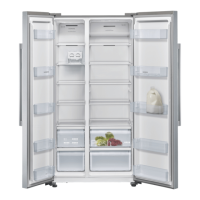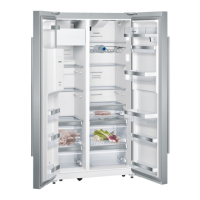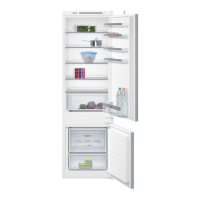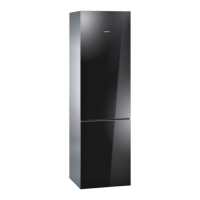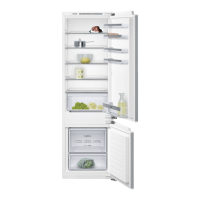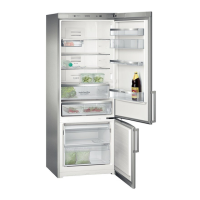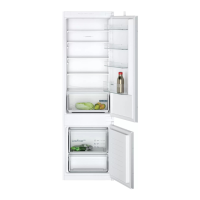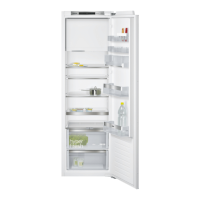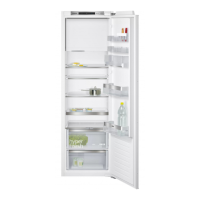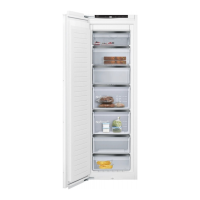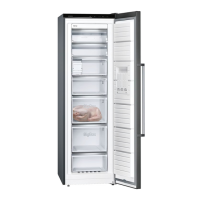Do you have a question about the Siemens KA93DVIFP and is the answer not in the manual?
| Child lock | Yes |
|---|---|
| Product color | Stainless steel |
| Product design | American door |
| Shelves material | Tempered glass |
| Custom panel-ready | - |
| Appliance placement | Freestanding |
| Noise level | 42 dB |
| Climate class | ST-T |
| Total net capacity | 562 L |
| Connected load | 374 W |
| Energy efficiency scale | A to G |
| Annual energy consumption | 404 kWh |
| Lamp type | LED |
| Fridge net capacity | 371 L |
| Fridge number of shelves/baskets | 4 |
| Star rating | 4* |
| Freezer position | Side-placed |
| Freezing capacity | 11 kg/24h |
| Freezer net capacity | 191 L |
| Storage time during power failure | 4 h |
| Depth | 710 mm |
|---|---|
| Width | 910 mm |
| Height | 1790 mm |
Read and follow installation and usage instructions for important information.
Avoid using electric appliances or storing flammable products inside the appliance.
Ensure proper installation and use of the mains cable; avoid damaged cables and unauthorized repairs.
Avoid prolonged skin contact with frozen food, ice, or tubes.
Do not store carbonated drinks in the freezer compartment as containers may burst.
Handle refrigerant carefully; if tubes are damaged, keep flames away, ventilate, and switch off.
Ensure supervision for children and people with limited abilities; only children 8+ may use the appliance.
Keep children away from packaging and its parts.
Appliance is for home use up to 2000m altitude.
Avoid standing on the appliance, keep plastic parts clean, pull plug not cord.
Appliance is heavy; requires at least two persons for transport and setup.
Dispose of packaging in an environmentally friendly manner.
Recycle old appliances; follow WEEE guidelines.
Check all delivered parts for transit damage and report complaints.
Appliance is heavy; at least two persons needed for safe transport and installation.
Doors can be unscrewed; only Customer Service should perform this task.
Install in a dry, well-ventilated room, away from heat sources and direct sunlight.
Ensure the floor is stable; reinforce if necessary.
Ensure proper ventilation for efficiency and energy saving; maintain specific distances from walls.
Use supplied spacers to ensure minimum distance between appliance and wall.
Observe specified dimensions for ventilation and full door opening.
Ensure door handles are securely tightened before use.
Use a spirit level to ensure the appliance is set correctly; adjust feet for leveling and door self-close.
Adjust the fridge door using a spanner to ensure it is level with the freezer door.
Connect to domestic cold water supply with minimum 2 bar and maximum 8 bar pressure.
Follow instructions for filter installation to prevent leaks and ensure proper function.
Use supplied hose and pads for water connection; manually connect to tap and filter nut.
Connect to a properly installed, accessible socket; use correct voltage and fuse; avoid extension leads.
After connecting water, check all points for leaks and tighten connectors if necessary.
Identify components within the freezer section, including LED light, ice maker, shelves, and drawers.
Identify components within the refrigerator section, including LED light, water filter, shelves, and drawers.
Understand the function of temperature displays, mode indicators, and control buttons.
Learn the specific actions of each button for temperature control, modes, and dispenser selection.
Initial power-on sequence includes display backlighting and buzzer sound.
Lock or unlock control panel and dispenser using the 'alarm/lock 3s' button.
Adjust freezer and refrigerator temperatures to optimal settings.
Refer to the rating plate for usable capacity details.
Use compartment for deep-frozen food, ice cubes, and freezing fresh food.
Check packaging, use-by dates, and supermarket temperature (-18°C or lower).
Drawers are telescopic; remove food before removing drawers.
Switch off ice maker if not needed to increase storage space.
Freeze undamaged food; blanch vegetables; avoid certain fruits and raw vegetables.
Use airtight containers, remove air, seal, and label for best flavor and to prevent drying.
Storage duration depends on food type and temperature (-18°C).
Symbols indicate permitted storage periods for different produce.
Activates rapid freezing to preserve nutrients and quality; recommended before adding large amounts of fresh food.
Thaw food at room temperature, in refrigerator, or in oven; do not refreeze thawed food unless pre-cooked.
Store fresh food; pack well to retain aroma and prevent flavor transfer.
Identify coldest and warmest zones for optimal food storage.
Use crisper for vegetables and fruit; some produce sensitive to cold should be stored outside.
Sets refrigerator to coldest setting for fast cooling of drinks or large food quantities.
Super cooling switches off automatically after 3 hours or can be manually turned off.
Press 'water' button; use glass against lever; water stops when glass is removed.
Automatically produces ice cubes when freezing temperature is reached.
Use 'ice off' button to conserve water and energy if ice is not needed.
Remove and empty ice bucket if ice clumps or for long periods of non-use.
Press 'cubed ice' or 'crushed ice' button; use suitable receptacle; avoid dispensing for over one minute.
Shelves and door racks are adjustable for flexible storage.
Alarm sounds for general alerts or specific issues like water filter replacement.
Activates if the door is left open for over 2 minutes.
Sets refrigerator to 15°C and freezer to -18°C for energy saving during absences; do not store food.
Optimizes temperatures (fridge 6°C, freezer -17°C) to reduce energy consumption.
Procedures for turning off and disconnecting the appliance.
NoFrost system ensures freezer remains ice-free; no manual defrosting required.
Defrosting is automatic via a drainage hole.
Use soft cloth, lukewarm water, and mild detergent; avoid abrasive cleaners and steam cleaners.
Clean water collecting tray and strainer; do not pull dispenser lever too hard.
Take out shelves and drawers for cleaning; open doors beyond 90 degrees.
Procedures for removing and handling the ice bucket.
Empty and clean the ice bucket with mild detergent; rinse and dry thoroughly.
Can be replaced by door rack to increase freezer volume.
Ensure couplers are aligned for correct connection when refitting.
If frost builds up, remove food, unplug, and ventilate to thaw.
Replace every 6 months or when display blinks/buzzer sounds after approx. 4000 liters.
Buy from retailer or customer service; ensure it's the correct type.
Close water valve, unscrew filter anticlockwise; expect minor water leakage.
Screw in new filter clockwise, reattach cover, and reset display by holding 'eco/filter reset' button.
Appliance features maintenance-free LED lighting, repairable by service technicians.
Install in dry, ventilated area, away from heat; cool food before storing; keep doors closed; turn off ice maker.
Guidance on normal operating noises and how to prevent them.
Check plug, fuse, and power supply; consider ambient temperature or defrost cycle.
Clean interior and remove sources of odour like food or packaging.
Normal during defrost, after loading warm food, or if ambient temperature is high; check door closure.
Check air outlets, ventilation, and door closure; remove frost if necessary.
Avoid frequent/long door openings; check for obstacles or insufficient clearance.
Check appliance tilt and interior for obstructions preventing door closure.
Check if door was open too long or if LED light is damaged.
Check water pan leveling, draining spout, and water connection tightness.
Verify water line, valve, filter, tank temperature, child lock, and door status.
Check water line, filter, ice bucket, chute, and ice maker status.
Provide appliance product (E-Nr.) and production (FD-Nr.) numbers for efficient support.
Contact information for countries is available on the enclosed Customer Service list.
